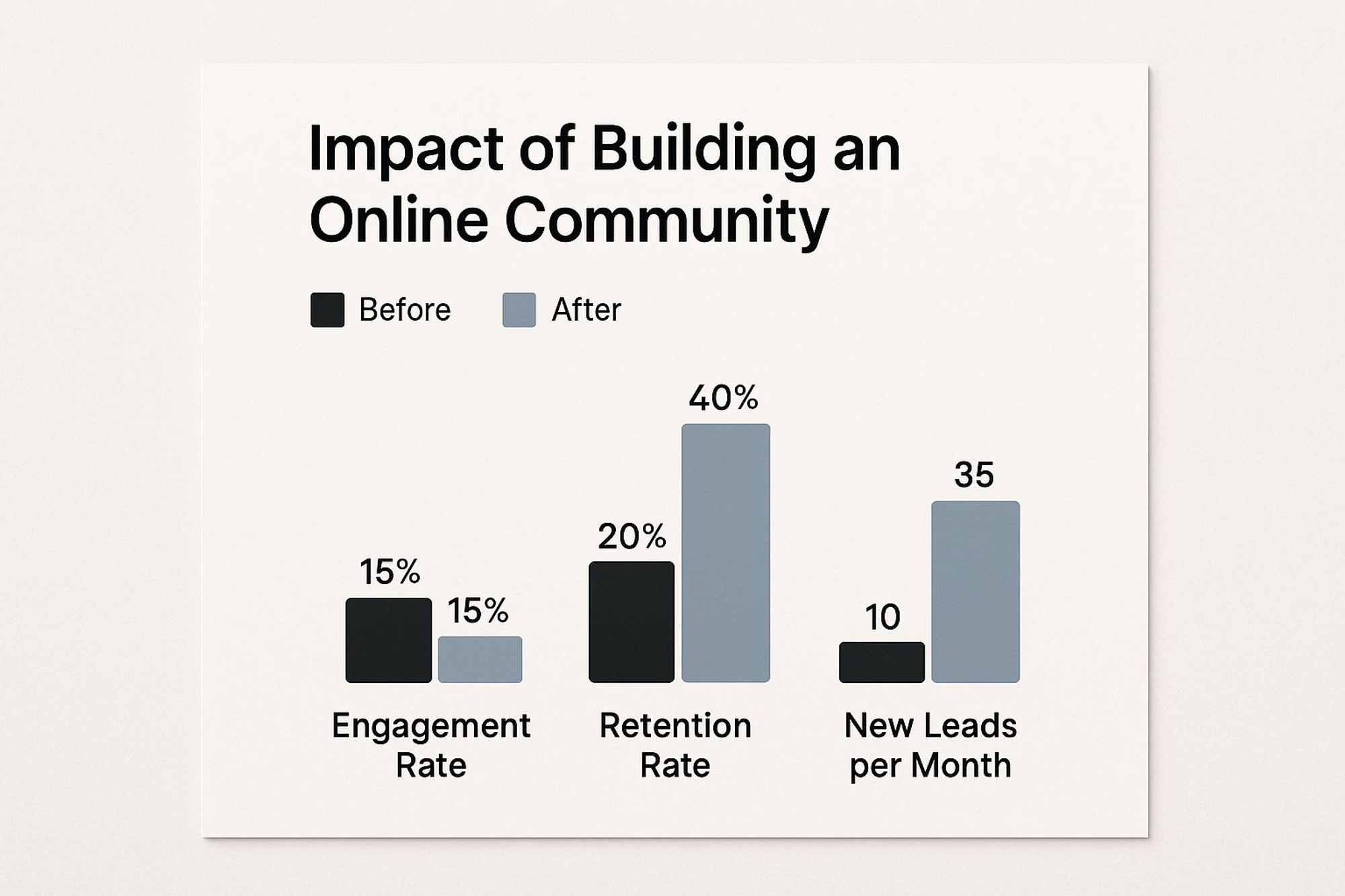Monday, June 30, 2025
Build Online Community: Strategies for Success


Before you can even think about launching a community, you have to answer two fundamental questions: Why should this exist? And who is it for?
This is the bedrock. Get this right, and every other decision—from your content to your engagement tactics—falls into place. It’s what separates a thriving digital hub from a digital ghost town.
Defining Your Community's Core Purpose
Building a vibrant online community doesn't happen by accident. It starts with a solid blueprint. This is the strategic work where you get brutally honest about your mission, pinpoint your ideal members, and pick the right digital home for everyone to gather.
Skipping this step is a recipe for a community that loses steam fast. But when you invest the time upfront, the payoff is huge. The infographic below shows just how much impact a well-defined community can have on key business metrics like engagement and retention.

As you can see, a focused community has the power to turn passive lurkers into your most active, loyal advocates.
Crafting Your Community Mission
Think of your mission as your community's North Star. It's a short, sharp statement that spells out its purpose, who it serves, and the value it delivers. It becomes the ultimate filter for every decision you make.
A good mission isn't some fluffy goal like "connecting people." It’s specific and all about the member. For instance, a company like Schedul wouldn't just create a generic community. Their mission might be: "A supportive network for digital creators to master cross-platform content strategy, share growth tactics for emerging networks, and find collaborative opportunities."
That single sentence tells you everything:
- Who it’s for: Digital creators (brand managers, social media marketers, podcasters).
- What they'll do: Master content strategy, share growth tactics, and collaborate.
- The ultimate value: Growing professionally and finding success on platforms like Threads and X.
A great mission statement acts as both a magnet for the right people and a repellent for the wrong ones. It ensures that everyone who joins shares a common understanding of why they are there, which is the bedrock of genuine connection.
Identifying Your Ideal Members
With your mission locked in, it's time to get laser-focused on the people you want to attract. This means creating a community member persona. You need to go way beyond basic demographics and dig into their real motivations, their biggest headaches, and their secret aspirations.
What keeps them up at night? Are they wrestling with content monetization? Feeling isolated on their creative journey? Or just desperate for solid tool recommendations?
When you understand their pain points, you can design an experience that feels like it was made just for them. You're not just building a space; you're solving a real problem for a specific group of people.
Choosing the Right Platform
You've got your "why" and your "who." Now for the "where." Your platform is more than just software; it's the home where your community's culture will grow.
It's no surprise that investment in this space is exploding. Projections show the online community platform market is set to grow from around $736.9 million in 2025 to a massive $2.4 billion by 2033. Businesses are waking up to the need for deeper consumer engagement. You can dive deeper into these market trends over at Cognitive Market Research.
Choosing the right home base for your community is a critical decision. It needs to align with your mission, your members' habits, and your own team's resources. A community for tech-savvy developers might feel right at home on a customizable, self-hosted platform. On the other hand, a fan community for a lifestyle brand might thrive in a simple Facebook Group where the audience already lives.
To help you weigh the options, here’s a quick breakdown of the most common platform types.
Choosing the Right Home for Your Community
This table compares the key features, control levels, and typical use cases for different community platforms to help you make an informed choice.
| Feature | Hosted Platforms (e.g., Circle, Mighty Networks) | Social Media Groups (e.g., Facebook, LinkedIn) | Self-Hosted (e.g., Discourse, WordPress + bbPress) |
|---|---|---|---|
| Ease of Use | High (plug-and-play) | Very High (familiar interface) | Low (requires technical skill) |
| Customization | Medium (branding and layout options) | Low (limited by platform rules) | Very High (total control over features) |
| Data Ownership | You own the member data | The social platform owns the data | You own everything |
| Monetization | Built-in subscription/course tools | Limited (often requires workarounds) | High (flexible, but you build it) |
| Best For | Paid memberships, courses, brand-owned hubs | Building on an existing audience, free communities | Niche topics, tech communities, full brand control |
Ultimately, the best platform is the one that removes friction for both you and your members. Don't overcomplicate it. Think about where your ideal members already are and what kind of experience will make them want to stick around.
Architecting the Member Experience
A truly great community doesn't just happen by accident—it’s meticulously designed. The moment someone new stumbles upon your space, their journey begins. Your job is to engineer an experience that makes them feel seen and valued from day one, not like just another number on a dashboard. This thoughtful architecture is what turns a loose group of individuals into a genuine, thriving ecosystem.

This whole process starts long before they ever post their first comment. It’s all about building a clear, supportive, and engaging path that guides them from discovery to becoming a fully participating member.
Designing a Frictionless Onboarding
First impressions are everything. A clunky, confusing, or overwhelming onboarding process is the quickest way to lose a potential member for good. The trick is to make joining feel both effortless and rewarding.
A welcome email is a good start, but why not take it up a notch? A short, personalized video from the community manager can make a world of difference. Instead of hitting them with a massive wall of text about the rules, create a simple, visually appealing "Start Here" guide.
This guide could be a single, pinned post or page that includes:
- A brief, warm welcome that reminds them why they joined.
- Simple instructions on how to complete their profile (and why it helps everyone).
- A direct link to one or two active, interesting discussions they can jump into right away.
- A quick intro to the community managers or moderators.
The goal is to give them just enough information to get started without making them feel like they have homework to do. This initial interaction sets the tone for their entire time in your community.
Crafting Positive and Clear Guidelines
Think of your community guidelines as more than just a list of "don'ts." They are a direct reflection of your community's culture and values. Try framing them positively, focusing on the kind of behavior you want to see rather than just forbidding the negative stuff. For example, instead of "Don't spam the group," you could say, "Share your awesome work in our dedicated weekly thread."
Your guidelines are the foundation for psychological safety. When members feel safe, they’re more willing to be vulnerable, share openly, and contribute in meaningful ways. This is what separates a transactional space from a real community.
Keep the language simple and clear. Ditch the legal jargon. Your guidelines should empower members to interact with confidence because they know exactly what's expected. This is a core responsibility of anyone managing a community. For a deeper dive into this role, check out our guide to becoming an effective online community manager.
Seeding Initial Discussions and Engagement
Nobody wants to walk into an empty room. An empty community feels just as intimidating. Before you even open the doors, you and your founding members need to seed the space with conversation starters. And I don’t mean generic "Welcome!" posts. These should be designed to spark real, genuine interaction.
Here are a few ideas for those crucial first discussion prompts:
- The "Intro with a Twist" Thread: "Introduce yourself and share the one tool you absolutely can't live without for your work."
- The "Weekly Wins" Post: Kick off a recurring thread where members can share their recent successes, big or small.
- The "Ask Me Anything" (AMA): Host an AMA with a founding member or an industry expert to deliver immediate value.
These initial threads act as a social lubricant, making it so much easier for new members to dive in. As you build out the member experience, the platform you choose is also critical. It's worth exploring creative solutions like the makerbox platform to find the right fit. Ultimately, your goal is to make that first contribution feel as easy and natural as possible.
Sparking Conversations and Lasting Engagement
An online community is only as good as the conversations happening within it. Once you've built the space, your real work begins: sparking the interactions that transform a quiet group into a thriving, self-sustaining hub. Think of yourself as the host of a great party—you make the intros, get fascinating topics started, and then, crucially, you know when to step back and let the magic happen.

This isn't about just tossing out random posts and hoping for the best. It’s about a thoughtful content strategy that makes people feel comfortable, inspired, and genuinely excited to share. Consistent, high-quality engagement doesn't just materialize; you have to cultivate it with purpose.
Content That Creates Connection
The content you share is what sets the tone for your entire community. Your goal isn't just to broadcast information—it's to create prompts that practically beg for a response. Every single post should be a conversation starter.
Live Q&A sessions are a fantastic way to do this. Bringing in an industry expert or even one of your own company leaders for a live chat delivers massive value and gets people talking in real time. Another great tactic is creating exclusive resources just for members, like a weekly insights newsletter or a handy downloadable template. Little things like that constantly reinforce the value of being in the group.
But let's be honest, the best content often comes from the members themselves. A strategy built around user-generated content (UGC) is non-negotiable. You need to create specific, recurring prompts for members to share their own stories, their work, and their expertise.
Establishing Community Rituals and Traditions
We're all creatures of habit. When you build rituals into your community, you create a predictable rhythm that members can look forward to and, more importantly, participate in. These shared experiences are the bedrock of a strong culture and that deep sense of belonging we're all after.
Think about creating some simple, repeatable weekly threads. They're easy to manage and incredibly effective.
- "Wins of the Week" Thread: A dedicated space for members to brag a little about their recent wins, big or small. This builds a super supportive and positive vibe.
- "Feedback Friday" Post: A structured, safe spot for members to post their work and get constructive feedback from peers.
- Monthly Creative Challenge: Toss out a theme or prompt that gets people to create something new—a piece of writing, a design, a new business strategy they tested.
These rituals are so much more than just content fillers. They become the inside jokes, the shared history, and the common ground that makes a group of strangers feel like a real team. To truly master this, you'll need to explore different strategies for online community management to see what fits your group's personality.
The best communities feel like they have their own culture, complete with unique traditions. These rituals are the heartbeat of the community, turning passive consumption into active participation and creating a powerful sense of identity.
The Community Manager as a Facilitator
As your community grows, your role will change. At first, you’re the one starting every conversation. But the long-term goal is to transition into a facilitator—someone who empowers others to take the lead. Your job is to spot the sparks of engagement and fan them into flames.
This means you need to be actively looking for the rising stars in your community. Who’s always the first to say hello to new members? Who consistently gives thoughtful, detailed advice? These people are your future advocates and potential moderators.
Once you’ve identified them, empower them.
- Recognize their contributions publicly. A simple shout-out goes a long, long way in making someone feel seen and valued.
- Ask for their opinion privately. Shoot them a DM to get their thoughts on a new idea you have for the community.
- Invite them to co-host an event. Give them a platform to share their own knowledge with the rest of the group.
By empowering your most active members, you don't just make them more invested; you also scale your own efforts. You can’t be in every single conversation, but you can absolutely build a network of leaders who carry the torch for your community's culture. For more tactical ideas, our guide on boosting community engagement on social media has some great tips you can adapt.
Ultimately, you'll know you've succeeded when the community thrives even when you aren't the one steering the ship.
Scaling Thoughtfully Without Losing Your Culture
Growth is exhilarating. Seeing those member numbers climb feels like a win, but it's a double-edged sword. If you're not careful, that rapid expansion can completely wash out the very culture that made your community special in the first place, turning a tight-knit space into just another noisy, impersonal forum.
The secret isn't to stop growing; it's to scale with intention. That means focusing on attracting the right people, not just more people.

This all comes down to being strategic about where you're promoting your community. Forget the "spray and pray" approach. Instead, concentrate your efforts on channels where your ideal members are already hanging out. Think targeted social media ads aimed at specific interests, features in niche newsletters, or collaborations with creators who already speak your language.
The numbers back this up. As of early 2025, we're looking at 5.24 billion active social media user identities across the globe. A staggering 97.3% of connected adults use at least one social platform every single month. These platforms are absolute goldmines for finding people who will genuinely connect with your mission.
Building a Strong Moderator Program
Look, as your community grows, you simply can't be everywhere at once. You won’t be able to personally greet every new member or read every single post. That's a fast track to burnout.
To protect your culture as you scale, you need to build a team of moderators—people who will act as its guardians. This isn't just a "nice to have"; it's a critical part of any long-term community management strategy.
So, where do you find them? They're probably already in your community. They’re the ones consistently welcoming newcomers, answering questions, and setting the positive tone you want to protect. Reach out to them personally. Invite them into a leadership role.
Once you’ve got your team, you need to set them up for success. Give them:
- A Clear Moderation Playbook: This is their bible. It should lay out the community guidelines, what to do when serious issues pop up, and the exact tone they should use when interacting with members.
- Regular Check-ins: Create a private channel just for your mods. It's a space for them to ask questions, vent about challenges, and support each other. This builds a real sense of camaraderie and keeps everyone on the same page.
- Real Empowerment: Trust your moderators. If you micromanage them, you'll crush their motivation. Give them the autonomy to make judgment calls and back them up.
This program does more than just lighten your load. It reinforces your culture by empowering your most dedicated members to become its champions.
Scaling your community's culture means scaling your leadership. A well-trained moderator team is an extension of your founding values, ensuring every new member experiences the same sense of safety and belonging as the first.
Keeping Conversations Personal at Scale
When a community blows up from a few hundred members to thousands, the main discussion feed can quickly become overwhelming. A single conversation gets derailed, and individual members start to feel like their voices are getting lost in the chaos.
The fix? Create smaller, more intimate spaces within the larger community.
This is where things like sub-groups, topic-specific channels, or dedicated forums are an absolute game-changer. By organizing conversations around specific interests, you let members self-select into the discussions that matter most to them. This structure is what keeps that personal, connected feeling alive, even as the overall member count soars.
Here are a few ways to do it:
- Topic-Based Channels: Carve out specific channels for things like
#tools-and-tech,#client-challenges, or#creative-inspiration. It keeps the main feed from turning into a junk drawer and funnels conversations to the right place. - Regional or Local Groups: If your members are spread out geographically, creating sub-groups for different cities or countries can spark local meetups and real-world connections.
- Skill-Level Groups: Having separate spaces for beginners, intermediate users, and experts is a fantastic way to let people ask questions and share advice at a level that feels right for them. No one feels intimidated or bored.
These smaller spaces stop the "firehose" effect of one massive, undifferentiated feed. They make it easy for members to find their people, build real relationships, and keep getting the value they signed up for in the first place.
Measuring Success and Demonstrating Value
So, you’ve built an amazing community. Now comes the hard part: proving it’s more than just a “nice-to-have.” To get long-term buy-in and resources, you have to show its real-world impact.
This means moving past surface-level stats like total member count and digging into the key performance indicators (KPIs) that actually matter to the business. When you can connect community chatter to tangible results, your community shifts from a cost center to a core business asset. It's not just about the numbers; it's about telling the story behind them.
Are people just signing up, or are they sticking around and participating? Is the conversation helpful and positive? Answering these questions is how you demonstrate real value.
Key Pillars of Community Measurement
To avoid drowning in data, it helps to organize your metrics around a few core pillars. Think of it as a balanced scorecard for your community’s health, giving you a holistic view of what's working and what isn't.
Your measurement strategy should really focus on three critical areas: engagement, growth, and overall sentiment. Each one gives you a different lens to see your community's performance, and together, they paint a powerful picture of its impact.
- Engagement: This is the pulse of your community. Are members actively involved, or is it a ghost town? Keep an eye on metrics like Daily Active Users (DAU), Monthly Active Users (MAU), post-to-comment ratios, and how quickly questions get answered. High engagement means your community is a go-to resource people genuinely find valuable.
- Growth: This isn’t just about how many new people join, but whether they're the right people. Sure, track your new member growth rate, but pay closer attention to their activation rate. How many new members actually post or comment within their first week? That tells you if you're attracting people who are truly aligned with your community's purpose.
- Sentiment: What’s the general vibe? While sentiment analysis tools can offer a starting point, nothing beats good old-fashioned manual observation. Are discussions supportive and constructive? Or are things starting to get a little toxic? A positive sentiment is a massive indicator of a healthy, safe-feeling space.
Connecting Community Metrics to Business Goals
This is where the rubber meets the road and you make your case to stakeholders. The ultimate goal is to draw a straight line from community activity to core business objectives. You need to show precisely how your efforts contribute to the bottom line or support wider company goals. For more on how this fits into your overall strategy, our guide on building a thriving social media community adds some great context.
A community's true value is often in how it indirectly influences key business metrics. The magic happens when you connect the dots between member engagement and outcomes like lower support costs, better customer retention, and a firehose of product feedback.
Let's look at how this plays out in the real world.
| Business Goal | Corresponding Community Metric(s) |
|---|---|
| Reduce Support Costs | The number of questions answered by other members; a noticeable drop in support tickets on topics already covered in the community. |
| Increase Customer Retention | Engagement levels of paying customers within the community; high scores on member satisfaction surveys. |
| Drive Product Innovation | The sheer volume of product feedback and feature ideas sourced from the community; number of members who volunteer for beta tests. |
| Boost Brand Awareness | Member growth rate; how much user-generated content gets shared outside the community. |
Creating a Feedback Loop for Improvement
Finally, remember that data should always lead to action. The metrics you're tracking are pointless if you don't use them to make the member experience better.
Set up a continuous feedback loop. Actively ask your members for their input. This isn't just about collecting data; it's about showing them you genuinely care about their experience and are committed to making the space theirs.
Simple surveys, casual polls, or even quick one-on-one chats with your most active members can provide priceless qualitative insights. Ask them what they love, what drives them crazy, and what they wish they saw more of. Combining this direct feedback with your hard data gives you the full story and a clear roadmap for making your community even better.
A Few Common Questions About Building a Community
As you start your journey into community building, you're bound to run into a few hurdles. It happens to everyone. Let's tackle some of the most common questions I hear, drawing from real-world experience to help you sidestep the pitfalls.
How Much Time Should I Expect to Spend Managing a New Community?
Be prepared to invest at least 1-2 hours every single day in the beginning. I can't stress this enough—that initial time commitment is non-negotiable if you want to build any real momentum. In those early days, you are the community's engine.
That time will be packed with personally welcoming every new person, seeding interesting discussion prompts, and jumping into conversations. Your goal is to make the space feel alive and responsive from day one. Later on, as members start talking amongst themselves, your role can become more strategic, but that initial hands-on effort is what gets you there.
What's the Best Way to Handle Conflict Between Members?
The key here is to act quickly, calmly, and privately. The second you sense things getting heated, your first move should be to pull up your community guidelines. Think of this document as your impartial rulebook.
From there, address the issue with the members involved through direct messages, not in a public showdown. You're a moderator, not a referee in a boxing ring. Your job is to de-escalate the situation and gently steer them back to the community's code of conduct. Public actions, like deleting posts or suspending someone, should be reserved for clear, undeniable violations of your rules—not for playing mediator in a disagreement.
The goal of conflict resolution isn't about picking a winner. It's about protecting the psychological safety of the entire community. A swift, private, and fair approach shows everyone that the space is well-managed and a safe place to participate.
This approach builds trust and positions you as a proactive, fair leader. For a much deeper look at setting up these foundational elements, this step-by-step guide on how to build an online community is a fantastic resource that really gets into the nitty-gritty.
Should I Charge People to Join My Community?
This is a big one, and the answer depends entirely on the unique value you're bringing to the table. There's no single "right" way to do it; both free and paid models work wonders when they're aligned with your goals.
- Free Communities: These are fantastic for building broad brand awareness, offering general customer support, or simply creating a large, top-of-funnel audience. With no barrier to entry, it's easier to attract members and cast a wide net.
- Paid Communities: This model really shines when you're offering something truly exclusive that people can't get just anywhere. We're talking about things like premium content, direct access to experts (including you), high-level networking, or structured courses. If you go this route, the value has to be incredibly clear and consistently delivered.
Think long and hard about what you’re offering. If it's information or connections members can easily find elsewhere for free, a paid model is going to be a tough sell.
How Do I Get My First 100 Members?
Whatever you do, resist the urge to just blast your community link all over the internet. Your first members aren't just numbers; they're your founding members. They set the tone for everything that follows, so quality is infinitely more important than quantity at this stage.
Forget mass promotion. Your first move should be personal, manual outreach.
Your best founding members are almost always hiding in plain sight within your existing network:
- Your most engaged email subscribers.
- Your most loyal customers or clients.
- Your most active and supportive social media followers.
Reach out to these people one by one with a personal message. Explain what you're building and, crucially, why you think they specifically would be a perfect addition. A personal invitation feels special and valued. Their early activity will breathe life into the community, making it feel vibrant and welcoming when you do eventually open the doors to a wider audience. This slow, intentional start is a huge part of learning how to get more social media followers who actually stick around.
Ready to turn these strategies into action? Schedul gives you the tools to plan, publish, and analyze your content across all your social channels. It helps you spark those crucial conversations and grow your community without all the manual busywork. See how you can build a thriving digital space by visiting https://www.schedulethreads.com.
No credit card required!